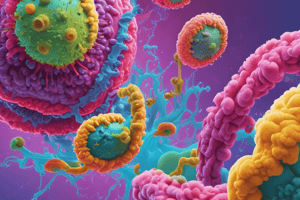Podcast
Questions and Answers
Which type of bacteria are responsible for digesting non-living food materials?
Which type of bacteria are responsible for digesting non-living food materials?
- Saprophytes (correct)
- Parasites
- Lactobacilli
- Coliform bacilli
What type of organisms are considered intermediate between a virus and a bacterium?
What type of organisms are considered intermediate between a virus and a bacterium?
- Rickettsiae (correct)
- Protozoa
- Fungi
- Coliform bacilli
Which diseases are caused by rickettsiae?
Which diseases are caused by rickettsiae?
- Influenza and Common cold
- Rocky Mountain spotted fever and Typhus fever (correct)
- Tuberculosis and Streptococcus
- Tetanus and Botulism
What type of microorganism is considered the human body's worst enemy?
What type of microorganism is considered the human body's worst enemy?
Which bacteria are known to help break down carbohydrates and combat disease-causing bacteria?
Which bacteria are known to help break down carbohydrates and combat disease-causing bacteria?
What is a common symptom of roundworms?
What is a common symptom of roundworms?
How are tapeworm eggs commonly transmitted?
How are tapeworm eggs commonly transmitted?
What is the study of parasitic worms known as?
What is the study of parasitic worms known as?
Which of the following is NOT a symptom commonly associated with pinworms?
Which of the following is NOT a symptom commonly associated with pinworms?
What illness is caused by Trichinella spiralis?
What illness is caused by Trichinella spiralis?
What are the primary symptoms of tapeworm infection?
What are the primary symptoms of tapeworm infection?
How does a person typically contract trichinosis?
How does a person typically contract trichinosis?
What additional symptoms may occur in patients infected with tapeworms?
What additional symptoms may occur in patients infected with tapeworms?
What characterizes the symptoms of threadworm infection?
What characterizes the symptoms of threadworm infection?
Where do flukes mature before they enter the human body?
Where do flukes mature before they enter the human body?
What is a possible hazard in the workplace regarding water contamination?
What is a possible hazard in the workplace regarding water contamination?
What are some ways flukes can enter the human body?
What are some ways flukes can enter the human body?
What is one of the symptoms that may indicate infection in an individual?
What is one of the symptoms that may indicate infection in an individual?
Which type of pathogen is known for causing diseases like Typhus?
Which type of pathogen is known for causing diseases like Typhus?
What is a distinguishing feature of protozoa compared to bacteria?
What is a distinguishing feature of protozoa compared to bacteria?
Which pathogen type primarily feeds on dead organisms?
Which pathogen type primarily feeds on dead organisms?
What are helminths classified as?
What are helminths classified as?
Which of the following pathogens cannot produce their own food?
Which of the following pathogens cannot produce their own food?
Flashcards
Pathogens
Pathogens
Tiny microorganisms that cause disease
Bacteria
Bacteria
One-celled organisms, some are helpful, some cause disease.
Rickettsiae
Rickettsiae
Organisms between bacteria and viruses, spread by insects
Viruses
Viruses
Signup and view all the flashcards
Bacteria types (saprophyte/parasite)
Bacteria types (saprophyte/parasite)
Signup and view all the flashcards
Parasitic Worm Class
Parasitic Worm Class
Signup and view all the flashcards
Helminth
Helminth
Signup and view all the flashcards
Roundworm Symptoms
Roundworm Symptoms
Signup and view all the flashcards
Tapeworm Transmission
Tapeworm Transmission
Signup and view all the flashcards
Trichinosis Cause
Trichinosis Cause
Signup and view all the flashcards
Tapeworm symptoms
Tapeworm symptoms
Signup and view all the flashcards
Threadworm symptom
Threadworm symptom
Signup and view all the flashcards
Trichinosis transmission
Trichinosis transmission
Signup and view all the flashcards
Trichinosis symptoms
Trichinosis symptoms
Signup and view all the flashcards
Flukes transmission
Flukes transmission
Signup and view all the flashcards
Flukes location
Flukes location
Signup and view all the flashcards
Contaminated water hazard
Contaminated water hazard
Signup and view all the flashcards
Fungi
Fungi
Signup and view all the flashcards
Parasites
Parasites
Signup and view all the flashcards
Study Notes
Pathogens
- Pathogens are tiny microorganisms that cause disease.
- Types of pathogens:
- Bacteria
- Rickettsiae
- Viruses
- Fungi
- Parasites
Bacteria
- Bacteria are one-celled microorganisms that are widespread.
- Bacteria digest non-living materials such as milk and meat.
- Some bacteria are called saprophytes or animal parasites.
- A parasite is an organism that lives in or on another organism and feeds on it.
- Examples of bacteria include toxins, which produce poison called botulism, tetanuses, and lockjaw.
Rickettsiae
- Rickettsiae are organisms that are considered intermediate between a virus and a bacterium.
- They grow in the intestinal tracts of insects.
- Examples of Rickettsiae are lice, mites, and ticks.
- Typhus is a rocky mountain spotted fever caused by rickettsia.
Viruses
- Viruses are small, simple life-like forms from one-half to 100 times smaller than bacteria.
- Viruses are the human body's worst enemy.
Fungi
- Fungi cannot make their own food.
- They live on dead animals, insects, and leaves.
- Examples include yeasts and mushrooms.
Parasites
- Parasites live on or inside other organisms.
- Parasites are classified as a disease.
- Examples of parasites are:
- Tapeworms
- Pinworms
- Roundworms
- Flukes
Other information
- Diseases caused by these organisms are:
- Amoebic dysentery
- Polio
- Viral hepatitis
- Chicken pox
- Mumps
- Measles
- Smallpox
- Shingles
- Cold sores
- Warts
- Trichinosis
Studying That Suits You
Use AI to generate personalized quizzes and flashcards to suit your learning preferences.




